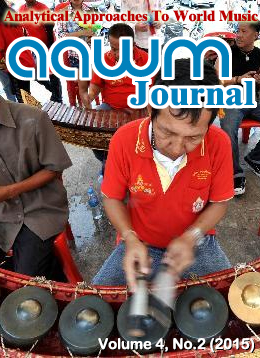 |
| |
 |
 |
|
 |
 |
|
AAWM JOURNAL Volume 4, No. 2 (2015) |
 |
 |
| Volume 4, No. 2 (2015) |
| |
 |
 |
| The Myth of Equidistance in Thai Tuning |
| John Garzoli (Monash University and Chulalongkorn University) |
| It is a long-standing and widely accepted theory that Thai classical music (phleng Thai doem) is based on a tempered tuning system that divides the octave into seven proportionally equal intervals of 171.429 cents, sometimes called “7-tet.” This theory was formulated in 1885 by Alexander J. Ellis, who made observations of fixed-pitch percussion instruments associated with the piphat ensemble. Although the theory is not corroborated by reliable data, it has not been seriously challenged. This paper identifies flaws with this theory and argues that it is incorrect to claim that Thai music is based on theoretical or realized equidistance. In questioning the theory, I consider a range of factors that influence Thai tuning, including the limitations of the tuning methods of fixed-pitch percussion instruments, the aims of those who tune and play the instruments and the non-harmonic proportions of the octave interval on these instruments. I discuss the failure of the equidistance theory to account for the tuning concepts and practices of vocalists and players of non-fixed-pitch instruments and the influence of piphat-associated practices regarding the development and circulation of musical ideas. I show that the theory of equidistance has historically been supported by scholars who have taken the unwarranted step of presupposing that the theory applies equally to all instruments, and I argue that the theory is sustained by data obtained through the use of suspect numerical testing methodologies. I conclude that the theory of equidistant tuning should be abandoned for lack of evidence to support it and incompleteness in its scope. A theory of Thai tuning must aim to accommodate the diverse reality of Thai musical practices and concepts rather attempt to reduce the explanation of Thai tuning to numerical terms... more >> |
| |
 |
 |
| Quantifying Musical Meter: How Similar are African and Western Rhythm? |
| Godfried Toussaint (New York University Abu Dhabi) |
| For a given family, corpus, style, or genre of musical rhythms, the pulse saliency histogram counts the relative frequency with which an onset occurs in each pulse position of the rhythm timespan (cycle, measure). Thus for a given fixed timespan a collection of rhythms may be expressed in its pulse saliency histogram (the empirical estimate of its probability distribution). The similarity of one group of rhythms to another group of rhythms or to theoretical models such as GTTM and its modifications may be measured by the degree to which their corresponding pulse saliency histograms are associated. The GTTM profile is characterized with four well-defined mathematical properties: alternations of strong and weak beats, pulse weight distribution, sub-symmetries, and fractal hierarchy. These properties provide quantitative methods for assessing the degree and nature of the structural similarities of rhythm corpora between each other and with regard to theoretical models of meter. Their usefulness is illustrated in the context of exploring the similarity of African and Western musical rhythms in terms of the quantity and type of meter they possess. In addition, several properties of metric hierarchies are uncovered that may characterize some of the differences between Renaissance music, Common Practice music, and German folk songs, as well as shed light on the complex evolution of meter in Western music and the relation of music to language... more >> |
|
|
 |
|
 |
 |
|



